1 of 5
Download to read offline
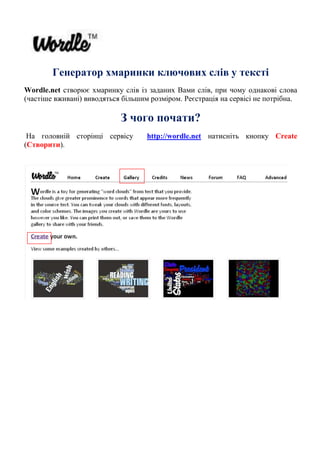
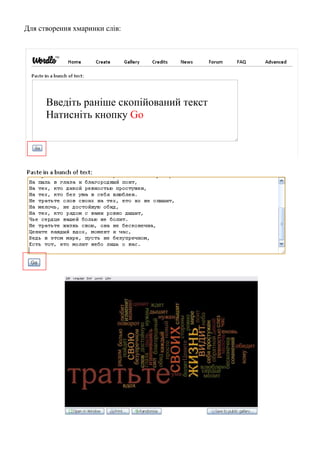
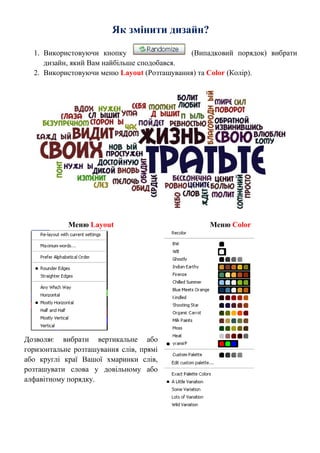
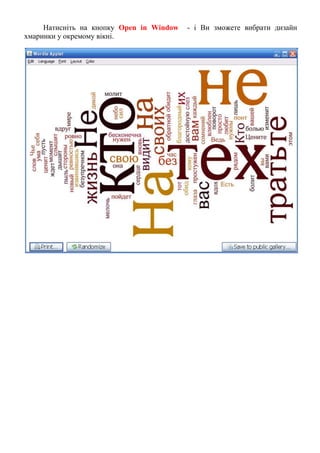
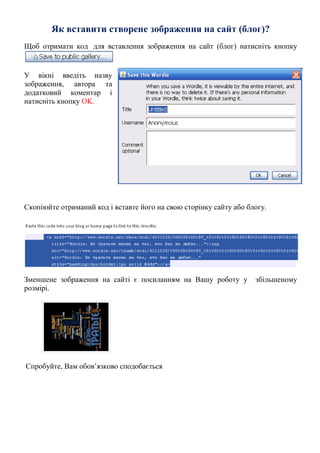
Ad
Recommended
ÐūÐ―ÐŧаÐđÐ― ŅÐĩŅÐēÐļŅ Tagul
ÐūÐ―ÐŧаÐđÐ― ŅÐĩŅÐēÐļŅ Tagulirinaknyazevaspb
Ėý
ÐÐ―ÐŧаÐđÐ―-ŅÐĩŅÐēÐļŅ Tagul ÐŋÐūзÐēÐūÐŧŅÐĩŅ ÐŋÐūÐŧŅзÐūÐēаŅÐĩÐŧŅО ŅÐūзÐīаÐēаŅŅ ŅÐ―ÐļКаÐŧŅÐ―ŅÐĩ ÐūÐąÐŧаКа ŅÐĩÐģÐūÐē ÐīÐŧŅ ÐąÐŧÐūÐģÐūÐē Ðļ ŅаÐđŅÐūÐē, ÐŋŅÐĩÐīÐŧаÐģаŅ ŅазÐŧÐļŅÐ―ŅÐĩ ŅÐūŅОŅ Ðļ ŅÐēÐĩŅÐūÐēŅÐĩ ŅŅ
ÐĩОŅ. ÐÐŧŅ ÐļŅÐŋÐūÐŧŅзÐūÐēÐ°Ð―ÐļŅ ŅÐĩŅÐēÐļŅа ŅŅÐĩÐąŅÐĩŅŅŅ ŅÐĩÐģÐļŅŅŅаŅÐļŅ, ÐŋÐūŅÐŧÐĩ ŅÐĩÐģÐū ОÐūÐķÐ―Ðū ÐēÐēÐūÐīÐļŅŅ ŅÐĩКŅŅ, ŅÐĩÐīаКŅÐļŅÐūÐēаŅŅ ÐĩÐģÐū Ðļ ÐēÐļзŅаÐŧÐļзÐļŅÐūÐēаŅŅ ÐūÐąÐŧаКа, ÐīÐūÐąÐ°ÐēÐŧŅŅ ŅÐūÐąŅŅÐēÐĩÐ―Ð―ŅÐĩ ÐļзÐūÐąŅаÐķÐĩÐ―ÐļŅ. ÐĄÐūŅ
ŅÐ°Ð―ÐĩÐ―Ð―ŅÐĩ ŅÐ°ÐąÐūŅŅ ОÐūÐģŅŅ ÐąŅŅŅ ŅКŅÐŋÐūŅŅÐļŅÐūÐēÐ°Ð―Ņ Ðē ŅÐūŅОаŅŅ PNG, EPS Ðļ SVG, а ŅаКÐķÐĩ ÐļÐ―ŅÐĩÐģŅÐļŅÐūÐēÐ°Ð―Ņ Ð―Ð° ŅаÐđŅŅ Ņ ÐŋÐūОÐūŅŅŅ HTML-КÐūÐīа.52 Interesting Ways to use Wordle in the Classroom
52 Interesting Ways to use Wordle in the ClassroomPastor Randy Lee
Ėý
52 ways to use Wordle in the classroom are presented. Some ideas include having students write about themselves and display the results in Wordle clouds, creating book quizzes by pasting book texts into Wordle, and using Wordle to share criteria or expectations for assignments. Wordle can also be used to analyze speeches, define vocabulary terms, compare themes in literature, and more. The document provides many creative ideas for incorporating the free online Wordle tool into classroom lessons and activities across subjects.ÐĪаŅÐļÐŧÐļŅаŅÐļŅ ŅазŅÐ°ÐąÐūŅКÐļ ÐŋŅÐūÐīŅКŅÐūÐēÐūÐđ ŅŅŅаŅÐĩÐģÐļÐļ: ОÐĩŅÐūÐī "ŅŅКÐūŅÐĩÐ―Ð―ÐūÐģÐū ŅÐūŅŅаÐđŅа"
ÐĪаŅÐļÐŧÐļŅаŅÐļŅ ŅазŅÐ°ÐąÐūŅКÐļ ÐŋŅÐūÐīŅКŅÐūÐēÐūÐđ ŅŅŅаŅÐĩÐģÐļÐļ: ОÐĩŅÐūÐī "ŅŅКÐūŅÐĩÐ―Ð―ÐūÐģÐū ŅÐūŅŅаÐđŅа" SQALab
Ėý
ÐÐūКŅОÐĩÐ―Ņ ÐūÐŋÐļŅŅÐēаÐĩŅ ОÐĩŅÐūÐīÐļКŅ 'ŅŅКÐūŅÐĩÐ―Ð―ÐūÐģÐū ŅÐūŅŅаÐđŅа' ÐīÐŧŅ ŅазŅÐ°ÐąÐūŅКÐļ ÐŋŅÐūÐīŅКŅÐūÐēÐūÐđ ŅŅŅаŅÐĩÐģÐļÐļ, аКŅÐĩÐ―ŅÐļŅŅŅ ÐēÐ―ÐļÐžÐ°Ð―ÐļÐĩ Ð―Ð° ŅаŅÐļÐŧÐļŅаŅÐļÐļ Ðļ КÐūÐŧÐŧÐĩКŅÐļÐēÐ―ÐūО ÐŋŅÐūÐģÐ―ÐūзÐļŅÐūÐēÐ°Ð―ÐļÐļ ÐąŅÐīŅŅÐĩÐģÐū. ÐÐ― ÐŋŅÐĩÐīÐŧаÐģаÐĩŅ ÐļÐ―ŅŅŅŅОÐĩÐ―ŅŅ ÐīÐŧŅ ÐŋÐūÐēŅŅÐĩÐ―ÐļŅ ŅŅŅÐĩКŅÐļÐēÐ―ÐūŅŅÐļ ÐģŅŅÐŋÐŋÐūÐēÐūÐđ ŅÐ°ÐąÐūŅŅ Ðļ ŅÐūзÐīÐ°Ð―ÐļŅ ŅŅŅаŅÐĩÐģÐļÐļ, КÐūŅÐūŅаŅ ŅŅÐļŅŅÐēаÐĩŅ ÐēÐŧÐļŅÐ―ÐļÐĩ ÐąŅÐīŅŅÐļŅ
ŅÐūÐąŅŅÐļÐđ Ð―Ð° ÐŋŅÐūÐīŅКŅ. ÐÐĩŅÐūÐī ÐēКÐŧŅŅаÐĩŅ Ðē ŅÐĩÐąŅ ŅазŅÐ°ÐąÐūŅКŅ ÐīÐūŅÐūÐķÐ―ÐūÐđ КаŅŅŅ Ðļ ÐēÐĩŅÐļŅÐļКаŅÐļŅ ÐŋŅÐūÐģÐ―ÐūзÐūÐē ŅÐĩŅÐĩз ÐģÐĩÐđОŅŅŅŅОÐļÐ―Ðģ, ÐŋÐūÐīŅÐĩŅКÐļÐēаŅ ÐēаÐķÐ―ÐūŅŅŅ ÐŋŅÐūаКŅÐļÐēÐ―ÐūÐģÐū ÐŋÐūÐīŅ
ÐūÐīа К ÐļзОÐĩÐ―ÐĩÐ―ÐļŅО.The hudson river_school_Korchev S. 10-A form
The hudson river_school_Korchev S. 10-A formJulia Birhova
Ėý
The Hudson River School was a 19th century American art movement known for romantic, detailed landscapes of the Hudson River Valley and surrounding areas. Key figures included Thomas Cole, who is considered the founder, and Frederic Edwin Church, who painted grand, panoramic landscapes influenced by travels in North and South America. Their paintings, influenced by romanticism, aimed to portray the beauty and drama of the American wilderness.ÐŅÐĩзÐĩÐ―ŅаŅŅŅ ÐīÐū ŅŅÐūКŅ з ŅÐĩОÐļ "ÐÐļŅŅÐĩŅŅÐēÐū"
ÐŅÐĩзÐĩÐ―ŅаŅŅŅ ÐīÐū ŅŅÐūКŅ з ŅÐĩОÐļ "ÐÐļŅŅÐĩŅŅÐēÐū"Julia Birhova
Ėý
Here are the responses in the past perfect tense:
1) When I arrived at the cinema, the film had started.
2) She had lived in China before she went to Thailand.
3) After they had eaten the shellfish, they began to feel sick.
4) If you had listened to me, you would have got the job.
5) When we had finished dinner, we went out.
6) The garden was dead because it had been dry all summer.
7) The lights went off because we had not paid the electricity bill.
8) The children had not done their homework, so they were in trouble.
9) They had not eatenTaxedo
TaxedoHelena Nikiforova
Ėý
ÐÐūКŅОÐĩÐ―Ņ ÐŋŅÐĩÐīŅŅаÐēÐŧŅÐĩŅ ŅÐūÐąÐūÐđ ÐļÐ―ŅŅŅŅКŅÐļŅ ÐŋÐū ÐļŅÐŋÐūÐŧŅзÐūÐēÐ°Ð―ÐļŅ ÐūÐąÐŧаКа ŅÐŧÐūÐē ÐÐļКÐļŅÐūŅÐūÐēа Ð.Ð., ÐūÐŋÐļŅŅÐēаŅŅŅŅ ŅазÐŧÐļŅÐ―ŅÐĩ ŅŅÐ―ÐšŅÐļÐļ, ŅаКÐļÐĩ КаК ÐēÐļзŅаÐŧÐļзаŅÐļŅ ŅÐĩКŅŅа, Ð―Ð°ŅŅŅÐūÐđКа ŅŅÐļŅŅÐūÐē Ðļ ŅÐēÐĩŅÐūÐēŅŅ
ÐūŅŅÐĩÐ―ÐšÐūÐē. ÐÐūÐŧŅзÐūÐēаŅÐĩÐŧÐļ ОÐūÐģŅŅ ÐŋŅÐļОÐĩÐ―ŅŅŅ ŅÐūŅÐĩŅÐ°Ð―ÐļŅ КÐŧаÐēÐļŅ ÐīÐŧŅ ŅÐĩÐīаКŅÐļŅÐūÐēÐ°Ð―ÐļŅ ŅÐĩКŅŅа, ÐļзОÐĩÐ―ŅŅŅ ŅаŅÐŋÐūÐŧÐūÐķÐĩÐ―ÐļÐĩ Ðļ ŅÐūŅОŅ ÐūÐąÐŧаКа, а ŅаКÐķÐĩ ŅÐūŅ
ŅÐ°Ð―ŅŅŅ Ðļ ÐīÐĩÐŧÐļŅŅŅŅ ŅÐĩзŅÐŧŅŅаŅаОÐļ. ÐÐ―ŅŅŅŅКŅÐļŅ ÐēКÐŧŅŅаÐĩŅ ÐēÐūзОÐūÐķÐ―ÐūŅŅŅ ŅÐĩÐģŅÐŧÐļŅÐūÐēÐ°Ð―ÐļŅ ÐŋаŅаОÐĩŅŅÐūÐē ŅÐĩКŅŅа Ðļ ŅаŅÐŋÐūÐŧÐūÐķÐĩÐ―ÐļŅ ŅÐŧÐūÐē ÐīÐŧŅ ÐŋÐūÐēŅŅÐĩÐ―ÐļŅ ŅŅŅÐĩКŅÐļÐēÐ―ÐūŅŅÐļ ÐēÐļзŅаÐŧÐļзаŅÐļÐļ.Autocad2dmodulaplikasi 131116195205-phpapp01
Autocad2dmodulaplikasi 131116195205-phpapp01Han Han
Ėý
Dokumen tersebut memberikan panduan langkah demi langkah untuk melukis objek 2D menggunakan perisian AutoCAD. Ia menerangkan bagaimana untuk membuka fail baru, menentukan saiz paparan grafik, menggunakan alat-alat lukisan seperti garisan, bulatan dan lengkung, serta arahan-arahan untuk mengubahsuai objek seperti offset, trim dan fillet. Dokumen ini berguna untuk mempelajari asas-asas melukis menggunakanPainting;hudson river school
Painting;hudson river schoolJulia Birhova
Ėý
The document discusses Pablo Picasso's quote about artists who can transform a yellow spot into the sun through their art and intelligence. It then provides definitions and brief descriptions of different genres of painting, including landscape painting, battle painting, seascape painting, still life, self-portrait, and the Hudson River School of American landscape painting. It notes Thomas Cole as the founder of the Hudson River School and provides short biographies of several prominent Hudson River School artists, including Albert Bierstadt, Frederic Edwin Church, Jasper Francis Cropsey, Asher Brown Durand, and William and James McDougal Hart.ÐĨОаŅÐļ зŅ ŅÐŧŅÐē
ÐĨОаŅÐļ зŅ ŅÐŧŅÐēÐŅÐļÐ―Ð° ÐÐļŅÐūÐ―ÐĩÐ―ÐšÐū
Ėý
ÐÐŧаŅŅÐūŅОÐļ ÐīÐŧŅ ŅŅÐēÐūŅÐĩÐ―Ð―Ņ Ņ
ОаŅEnhancing Learning with Technology
Enhancing Learning with TechnologyCameron Paterson
Ėý
The document provides three links to online resources about enhancing learning with technology. The first link is to a website called "Where's My Helmet?" about Dan Pink's book "A Whole New Mind". The second link is to a YouTube video about the construction of Canberra. The third item mentions Michael Fullan and includes a reference to a Zen ink painting by Hakuin Ekaku.Web 2 tools etime reading
Web 2 tools etime readingJanice
Ėý
Web 2.0 tools such as blogs and podcasts can effectively support reading achievement in K-12 students. They provide collaborative environments to expand reading and writing skills in areas like fluency, vocabulary, and text comprehension. Blogs allow for creativity and ownership in the reading/writing process, while podcasts can impact vocabulary development and comprehension through audio resources. Creating podcasts of readers' theater, oral readings, or book reports encourages repetition, rereading, and public performance, motivating students and improving their work.engineering drawing 101(b)
engineering drawing 101(b)kuroblack0921
Ėý
This document defines and describes different types of lines used in technical drawings. It discusses visible and hidden object lines, dimension lines, extension lines, center lines, leader lines, cutting plane lines, reference lines, repeated/ditto lines, break lines, and hatching lines. For each line type, it provides details on the line weight, style, and purpose. The document serves as a reference for the proper application of various line types in technical drawings.Ethan pendergraft read 180 next generation research presentation
Ethan pendergraft read 180 next generation research presentationliteracyassessments
Ėý
The READ 180 Next Generation program provides intensive reading intervention for struggling readers in grades 4-12 who are two years below grade level. It uses differentiated instructional software, leveled literature, and focuses on reading, writing, and vocabulary skills. The program helps students take ownership of their learning and prepares them for the rigor and writing demands of the Common Core State Standards. Studies found READ 180 improved comprehension and literacy achievement, with some students gaining one to two years' worth of reading growth.Tips for teaching with CALL-Chapter 3:"Reading"
Tips for teaching with CALL-Chapter 3:"Reading"elisapaslawski
Ėý
The document provides tips for teaching reading with computer-assisted language learning (CALL). It discusses selecting appropriate reading texts at the right difficulty level. It recommends emphasizing important words and providing opportunities for learners to interact with texts by clicking for help. Teachers should let CALL texts spark discussion among learners and choose materials that explicitly teach language. Evaluation of comprehension and language knowledge helps focus learners on what they are learning. Teachers should help develop strategies for online reading.Expanding Reading With An Integrated Wiki
Expanding Reading With An Integrated Wikic j
Ėý
The document presents a project aimed at fostering a reading culture and expanding vocabulary through an integrated wiki, specifically targeting English language learners. It includes various references to research and literature in the fields of e-learning, language teaching, and collaborative learning. The author seeks feedback and suggestions to enhance the initiative, which was presented at TESOL Arabia in March 2010.Reading fluency
Reading fluencysvit vasad
Ėý
The document discusses effective reading skills and fluency. It introduces the importance of reading both for students and professionals. It explains that the purpose of reading is to connect new ideas to existing knowledge. The document then discusses reading rates and tips to increase reading speed, such as avoiding focusing on individual words and reading in word groups. It also covers comprehension, reasons for poor comprehension, and ways to improve comprehension skills, such as reading a variety of materials and understanding context. Finally, it discusses techniques like skimming, scanning, understanding text structure and punctuation to aid reading.ÐŋŅÐĩзÐĩÐ―ŅаŅŅŅ ÐĩÐēŅÐļŅŅÐļŅÐ―Ðĩ Ð―Ð°ÐēŅÐ°Ð―Ð―Ņ
ÐŋŅÐĩзÐĩÐ―ŅаŅŅŅ ÐĩÐēŅÐļŅŅÐļŅÐ―Ðĩ Ð―Ð°ÐēŅÐ°Ð―Ð―ŅAlusya
Ėý
ÐēÐļŅŅŅÐŋ Ð―Ð° ÐŋÐĩÐīŅаÐīŅCognitive factors that affecting reading comprehension
Cognitive factors that affecting reading comprehensionjeanecarlaong
Ėý
Decoding speed, vocabulary, and cognitive factors like attention and motivation can impact a reader's comprehension. As readers develop, comprehension requires understanding words, sentences, and symbolic meaning. Comprehension depends on quickly recognizing words and determining meaning. A large vocabulary allows faster interpretation, while limited vocabulary slows understanding. Distracted or unmotivated readers may reread without comprehending. Poorly written text can decrease speed and hinder comprehension by challenging decoding, syntax, and motivation.Ð ÐĩзŅÐŧŅŅаŅÐļ ÐūÐŧŅОÐŋŅаÐīÐļ з Ð°Ð―ÐģÐŧŅÐđŅŅКÐūŅ ОÐūÐēÐļ
Ð ÐĩзŅÐŧŅŅаŅÐļ ÐūÐŧŅОÐŋŅаÐīÐļ з Ð°Ð―ÐģÐŧŅÐđŅŅКÐūŅ ОÐūÐēÐļolena2605
Ėý
ÐŅÐąŅÐūÐēÐļŅŅКÐļÐđ Ð ÐÐÐ ÐĩзŅÐŧŅŅаŅÐļ ÐÐ ÐĩŅаÐŋŅ ÐūÐŧŅОÐŋŅаÐīÐļ з ÐŋŅаÐēÐūÐ·Ð―Ð°ÐēŅŅÐēа
Ð ÐĩзŅÐŧŅŅаŅÐļ ÐÐ ÐĩŅаÐŋŅ ÐūÐŧŅОÐŋŅаÐīÐļ з ÐŋŅаÐēÐūÐ·Ð―Ð°ÐēŅŅÐēаÐŪŅŅÐđ Ð ÐūÐžÐ°Ð―ŅŅКÐū
Ėý
Ð ÐĩзŅÐŧŅŅаŅÐļ ÐÐ ÐĩŅаÐŋŅ ÐūÐŧŅОÐŋŅаÐīÐļ з ÐŋŅаÐēÐūÐ·Ð―Ð°ÐēŅŅÐēÐ°Ð―Ð°ÐšÐ°Ð· â 133 ÐēŅÐī 05.04.2016 ÐŋŅÐū ŅÐĩзŅÐŧŅŅаŅÐļÐēÐ―ŅŅŅŅ Ðē ÐūÐąÐŧаŅÐ―ÐļŅ
ÐūÐŧŅОÐŋŅаÐīаŅ
КÐūÐŋŅŅ
Ð―Ð°ÐšÐ°Ð· â 133 ÐēŅÐī 05.04.2016 ÐŋŅÐū ŅÐĩзŅÐŧŅŅаŅÐļÐēÐ―ŅŅŅŅ Ðē ÐūÐąÐŧаŅÐ―ÐļŅ
ÐūÐŧŅОÐŋŅаÐīаŅ
КÐūÐŋŅŅolena2605
Ėý
ÐŅÐąŅÐūÐēÐļŅŅКÐļÐđ Ð ÐÐÐ ÐĩзŅÐŧŅŅаŅÐļ ÐÐ ÐĩŅаÐŋŅ ÐūÐŧŅОÐŋŅаÐīÐļ з ŅŅŅÐūŅŅŅ
Ð ÐĩзŅÐŧŅŅаŅÐļ ÐÐ ÐĩŅаÐŋŅ ÐūÐŧŅОÐŋŅаÐīÐļ з ŅŅŅÐūŅŅŅÐŪŅŅÐđ Ð ÐūÐžÐ°Ð―ŅŅКÐū
Ėý
Ð ÐĩзŅÐŧŅŅаŅÐļ ÐÐ ÐĩŅаÐŋŅ ÐūÐŧŅОÐŋŅаÐīÐļ з ŅŅŅÐūŅŅŅÐŧÐļŅŅ ŅÐ―ŅÐūŅОаŅÐļКа (3 ÐĩŅаÐŋ)
ÐŧÐļŅŅ ŅÐ―ŅÐūŅОаŅÐļКа (3 ÐĩŅаÐŋ)NataSysoenko
Ėý
ÐÐĩŅÐūÐīÐļŅÐ―Ņ ŅÐĩКÐūОÐĩÐ―ÐīаŅŅŅŅÐūÐīÐū ÐŋŅÐūÐēÐĩÐīÐĩÐ―Ð―Ņ 3 ÐĩŅаÐŋŅ ÐŅÐĩŅКŅаŅÐ―ŅŅКÐūŅ ÐūÐŧŅОÐŋŅаÐīÐļ з ŅÐ―ŅÐūŅОаŅÐļКÐļ Ņ 2012-13 Ð―.Ņ.More Related Content
Viewers also liked (17)
Painting;hudson river school
Painting;hudson river schoolJulia Birhova
Ėý
The document discusses Pablo Picasso's quote about artists who can transform a yellow spot into the sun through their art and intelligence. It then provides definitions and brief descriptions of different genres of painting, including landscape painting, battle painting, seascape painting, still life, self-portrait, and the Hudson River School of American landscape painting. It notes Thomas Cole as the founder of the Hudson River School and provides short biographies of several prominent Hudson River School artists, including Albert Bierstadt, Frederic Edwin Church, Jasper Francis Cropsey, Asher Brown Durand, and William and James McDougal Hart.ÐĨОаŅÐļ зŅ ŅÐŧŅÐē
ÐĨОаŅÐļ зŅ ŅÐŧŅÐēÐŅÐļÐ―Ð° ÐÐļŅÐūÐ―ÐĩÐ―ÐšÐū
Ėý
ÐÐŧаŅŅÐūŅОÐļ ÐīÐŧŅ ŅŅÐēÐūŅÐĩÐ―Ð―Ņ Ņ
ОаŅEnhancing Learning with Technology
Enhancing Learning with TechnologyCameron Paterson
Ėý
The document provides three links to online resources about enhancing learning with technology. The first link is to a website called "Where's My Helmet?" about Dan Pink's book "A Whole New Mind". The second link is to a YouTube video about the construction of Canberra. The third item mentions Michael Fullan and includes a reference to a Zen ink painting by Hakuin Ekaku.Web 2 tools etime reading
Web 2 tools etime readingJanice
Ėý
Web 2.0 tools such as blogs and podcasts can effectively support reading achievement in K-12 students. They provide collaborative environments to expand reading and writing skills in areas like fluency, vocabulary, and text comprehension. Blogs allow for creativity and ownership in the reading/writing process, while podcasts can impact vocabulary development and comprehension through audio resources. Creating podcasts of readers' theater, oral readings, or book reports encourages repetition, rereading, and public performance, motivating students and improving their work.engineering drawing 101(b)
engineering drawing 101(b)kuroblack0921
Ėý
This document defines and describes different types of lines used in technical drawings. It discusses visible and hidden object lines, dimension lines, extension lines, center lines, leader lines, cutting plane lines, reference lines, repeated/ditto lines, break lines, and hatching lines. For each line type, it provides details on the line weight, style, and purpose. The document serves as a reference for the proper application of various line types in technical drawings.Ethan pendergraft read 180 next generation research presentation
Ethan pendergraft read 180 next generation research presentationliteracyassessments
Ėý
The READ 180 Next Generation program provides intensive reading intervention for struggling readers in grades 4-12 who are two years below grade level. It uses differentiated instructional software, leveled literature, and focuses on reading, writing, and vocabulary skills. The program helps students take ownership of their learning and prepares them for the rigor and writing demands of the Common Core State Standards. Studies found READ 180 improved comprehension and literacy achievement, with some students gaining one to two years' worth of reading growth.Tips for teaching with CALL-Chapter 3:"Reading"
Tips for teaching with CALL-Chapter 3:"Reading"elisapaslawski
Ėý
The document provides tips for teaching reading with computer-assisted language learning (CALL). It discusses selecting appropriate reading texts at the right difficulty level. It recommends emphasizing important words and providing opportunities for learners to interact with texts by clicking for help. Teachers should let CALL texts spark discussion among learners and choose materials that explicitly teach language. Evaluation of comprehension and language knowledge helps focus learners on what they are learning. Teachers should help develop strategies for online reading.Expanding Reading With An Integrated Wiki
Expanding Reading With An Integrated Wikic j
Ėý
The document presents a project aimed at fostering a reading culture and expanding vocabulary through an integrated wiki, specifically targeting English language learners. It includes various references to research and literature in the fields of e-learning, language teaching, and collaborative learning. The author seeks feedback and suggestions to enhance the initiative, which was presented at TESOL Arabia in March 2010.Reading fluency
Reading fluencysvit vasad
Ėý
The document discusses effective reading skills and fluency. It introduces the importance of reading both for students and professionals. It explains that the purpose of reading is to connect new ideas to existing knowledge. The document then discusses reading rates and tips to increase reading speed, such as avoiding focusing on individual words and reading in word groups. It also covers comprehension, reasons for poor comprehension, and ways to improve comprehension skills, such as reading a variety of materials and understanding context. Finally, it discusses techniques like skimming, scanning, understanding text structure and punctuation to aid reading.ÐŋŅÐĩзÐĩÐ―ŅаŅŅŅ ÐĩÐēŅÐļŅŅÐļŅÐ―Ðĩ Ð―Ð°ÐēŅÐ°Ð―Ð―Ņ
ÐŋŅÐĩзÐĩÐ―ŅаŅŅŅ ÐĩÐēŅÐļŅŅÐļŅÐ―Ðĩ Ð―Ð°ÐēŅÐ°Ð―Ð―ŅAlusya
Ėý
ÐēÐļŅŅŅÐŋ Ð―Ð° ÐŋÐĩÐīŅаÐīŅCognitive factors that affecting reading comprehension
Cognitive factors that affecting reading comprehensionjeanecarlaong
Ėý
Decoding speed, vocabulary, and cognitive factors like attention and motivation can impact a reader's comprehension. As readers develop, comprehension requires understanding words, sentences, and symbolic meaning. Comprehension depends on quickly recognizing words and determining meaning. A large vocabulary allows faster interpretation, while limited vocabulary slows understanding. Distracted or unmotivated readers may reread without comprehending. Poorly written text can decrease speed and hinder comprehension by challenging decoding, syntax, and motivation.Ð ÐĩзŅÐŧŅŅаŅÐļ ÐūÐŧŅОÐŋŅаÐīÐļ з Ð°Ð―ÐģÐŧŅÐđŅŅКÐūŅ ОÐūÐēÐļ
Ð ÐĩзŅÐŧŅŅаŅÐļ ÐūÐŧŅОÐŋŅаÐīÐļ з Ð°Ð―ÐģÐŧŅÐđŅŅКÐūŅ ОÐūÐēÐļolena2605
Ėý
ÐŅÐąŅÐūÐēÐļŅŅКÐļÐđ Ð ÐÐÐ ÐĩзŅÐŧŅŅаŅÐļ ÐÐ ÐĩŅаÐŋŅ ÐūÐŧŅОÐŋŅаÐīÐļ з ÐŋŅаÐēÐūÐ·Ð―Ð°ÐēŅŅÐēа
Ð ÐĩзŅÐŧŅŅаŅÐļ ÐÐ ÐĩŅаÐŋŅ ÐūÐŧŅОÐŋŅаÐīÐļ з ÐŋŅаÐēÐūÐ·Ð―Ð°ÐēŅŅÐēаÐŪŅŅÐđ Ð ÐūÐžÐ°Ð―ŅŅКÐū
Ėý
Ð ÐĩзŅÐŧŅŅаŅÐļ ÐÐ ÐĩŅаÐŋŅ ÐūÐŧŅОÐŋŅаÐīÐļ з ÐŋŅаÐēÐūÐ·Ð―Ð°ÐēŅŅÐēÐ°Ð―Ð°ÐšÐ°Ð· â 133 ÐēŅÐī 05.04.2016 ÐŋŅÐū ŅÐĩзŅÐŧŅŅаŅÐļÐēÐ―ŅŅŅŅ Ðē ÐūÐąÐŧаŅÐ―ÐļŅ
ÐūÐŧŅОÐŋŅаÐīаŅ
КÐūÐŋŅŅ
Ð―Ð°ÐšÐ°Ð· â 133 ÐēŅÐī 05.04.2016 ÐŋŅÐū ŅÐĩзŅÐŧŅŅаŅÐļÐēÐ―ŅŅŅŅ Ðē ÐūÐąÐŧаŅÐ―ÐļŅ
ÐūÐŧŅОÐŋŅаÐīаŅ
КÐūÐŋŅŅolena2605
Ėý
ÐŅÐąŅÐūÐēÐļŅŅКÐļÐđ Ð ÐÐÐ ÐĩзŅÐŧŅŅаŅÐļ ÐÐ ÐĩŅаÐŋŅ ÐūÐŧŅОÐŋŅаÐīÐļ з ŅŅŅÐūŅŅŅ
Ð ÐĩзŅÐŧŅŅаŅÐļ ÐÐ ÐĩŅаÐŋŅ ÐūÐŧŅОÐŋŅаÐīÐļ з ŅŅŅÐūŅŅŅÐŪŅŅÐđ Ð ÐūÐžÐ°Ð―ŅŅКÐū
Ėý
Ð ÐĩзŅÐŧŅŅаŅÐļ ÐÐ ÐĩŅаÐŋŅ ÐūÐŧŅОÐŋŅаÐīÐļ з ŅŅŅÐūŅŅŅÐ ÐĩзŅÐŧŅŅаŅÐļ ÐÐ ÐĩŅаÐŋŅ ÐūÐŧŅОÐŋŅаÐīÐļ з ÐŋŅаÐēÐūÐ·Ð―Ð°ÐēŅŅÐēа
Ð ÐĩзŅÐŧŅŅаŅÐļ ÐÐ ÐĩŅаÐŋŅ ÐūÐŧŅОÐŋŅаÐīÐļ з ÐŋŅаÐēÐūÐ·Ð―Ð°ÐēŅŅÐēаÐŪŅŅÐđ Ð ÐūÐžÐ°Ð―ŅŅКÐū
Ėý
Ð―Ð°ÐšÐ°Ð· â 133 ÐēŅÐī 05.04.2016 ÐŋŅÐū ŅÐĩзŅÐŧŅŅаŅÐļÐēÐ―ŅŅŅŅ Ðē ÐūÐąÐŧаŅÐ―ÐļŅ
ÐūÐŧŅОÐŋŅаÐīаŅ
КÐūÐŋŅŅ
Ð―Ð°ÐšÐ°Ð· â 133 ÐēŅÐī 05.04.2016 ÐŋŅÐū ŅÐĩзŅÐŧŅŅаŅÐļÐēÐ―ŅŅŅŅ Ðē ÐūÐąÐŧаŅÐ―ÐļŅ
ÐūÐŧŅОÐŋŅаÐīаŅ
КÐūÐŋŅŅolena2605
Ėý
Ð ÐĩзŅÐŧŅŅаŅÐļ ÐÐ ÐĩŅаÐŋŅ ÐūÐŧŅОÐŋŅаÐīÐļ з ŅŅŅÐūŅŅŅ
Ð ÐĩзŅÐŧŅŅаŅÐļ ÐÐ ÐĩŅаÐŋŅ ÐūÐŧŅОÐŋŅаÐīÐļ з ŅŅŅÐūŅŅŅÐŪŅŅÐđ Ð ÐūÐžÐ°Ð―ŅŅКÐū
Ėý
More from NataSysoenko (19)
ÐŧÐļŅŅ ŅÐ―ŅÐūŅОаŅÐļКа (3 ÐĩŅаÐŋ)
ÐŧÐļŅŅ ŅÐ―ŅÐūŅОаŅÐļКа (3 ÐĩŅаÐŋ)NataSysoenko
Ėý
ÐÐĩŅÐūÐīÐļŅÐ―Ņ ŅÐĩКÐūОÐĩÐ―ÐīаŅŅŅŅÐūÐīÐū ÐŋŅÐūÐēÐĩÐīÐĩÐ―Ð―Ņ 3 ÐĩŅаÐŋŅ ÐŅÐĩŅКŅаŅÐ―ŅŅКÐūŅ ÐūÐŧŅОÐŋŅаÐīÐļ з ŅÐ―ŅÐūŅОаŅÐļКÐļ Ņ 2012-13 Ð―.Ņ.Timetoast
TimetoastNataSysoenko
Ėý
ÐÐ―ŅŅŅŅКŅŅŅ ÐŋÐū ŅÐūÐąÐūŅŅ з ŅÐĩŅÐēŅŅÐūО ÐīÐŧŅ ŅŅÐēÐūŅÐĩÐ―Ð―Ņ ÐŧŅÐ―ŅÐđКÐļ ŅаŅŅ101 ŅÐŋÐūŅŅÐą ÐēÐļКÐūŅÐļŅŅÐ°Ð―Ð―Ņ tagxedo
101 ŅÐŋÐūŅŅÐą ÐēÐļКÐūŅÐļŅŅÐ°Ð―Ð―Ņ tagxedoNataSysoenko
Ėý
ÐÐļКÐūŅÐļŅŅÐ°Ð―Ð―Ņ ŅÐĩŅÐēŅŅŅ tagxedo Ðē Ð―Ð°ÐēŅаÐŧŅÐ―ŅÐđ ÐīŅŅÐŧŅÐ―ÐūŅŅŅ.Ð ÐūÐąÐūŅа з ŅÐĩŅÐēŅŅÐūО šÝšÝßĢshare
Ð ÐūÐąÐūŅа з ŅÐĩŅÐēŅŅÐūО šÝšÝßĢshareNataSysoenko
Ėý
ÐаÐēŅаÐŧŅÐ―Ð° ÐŋŅÐĩзÐĩÐ―ŅаŅŅŅ ÐŋÐū ŅÐūÐąÐūŅŅ зŅ šÝšÝßĢshareÐąÐĩзКÐūŅŅÐūÐēÐ―Ņ ŅÐ―ŅŅŅŅОÐĩÐ―ŅÐļ Microsoft ÐīÐŧŅ ÐēŅÐļŅÐĩÐŧŅÐē Ņ ÐēÐļКÐŧаÐīаŅŅÐē
ÐąÐĩзКÐūŅŅÐūÐēÐ―Ņ ŅÐ―ŅŅŅŅОÐĩÐ―ŅÐļ Microsoft ÐīÐŧŅ ÐēŅÐļŅÐĩÐŧŅÐē Ņ ÐēÐļКÐŧаÐīаŅŅÐēNataSysoenko
Ėý
ÐÐūÐ―ÐšŅŅŅ "ÐÐūÐąÐĩŅ-2010" ÐĢ ÐĨÐĩŅŅÐūÐ―ŅŅКŅÐđ ÐūÐąÐŧаŅŅŅ
ÐÐūÐ―ÐšŅŅŅ "ÐÐūÐąÐĩŅ-2010" ÐĢ ÐĨÐĩŅŅÐūÐ―ŅŅКŅÐđ ÐūÐąÐŧаŅŅŅNataSysoenko
Ėý
Ð ÐĩзŅÐŧŅŅаŅÐļ ŅŅаŅŅŅ заÐģаÐŧŅÐ―ÐūÐūŅÐēŅŅÐ―ŅŅ
Ð―Ð°ÐēŅаÐŧŅÐ―ÐļŅ
заКÐŧаÐīŅÐē ÐĨÐĩŅŅÐūÐ―ŅŅКÐūŅ ÐūÐąÐŧаŅŅŅ Ņ ÐŅÐķÐ―Ð°ŅÐūÐīÐ―ÐūОŅ КÐūÐ―ÐšŅŅŅŅ з ŅÐ―ŅÐūŅОаŅÐļКÐļ Ņа КÐūОÐŋ'ŅŅÐĩŅÐ―ÐūŅ ÐģŅаОÐūŅÐ―ÐūŅŅŅ "ÐÐūÐąÐĩŅ" Ņ 2010 Ð―Ð°ÐēŅаÐŧŅÐ―ÐūОŅ ŅÐūŅŅÐąÐĩзКÐūŅŅÐūÐēÐ―Ņ ŅÐ―ŅŅŅŅОÐĩÐ―ŅÐļ Microsoft ÐīÐŧŅ ÐēŅÐļŅÐĩÐŧŅÐē Ņ ÐēÐļКÐŧаÐīаŅŅÐē
ÐąÐĩзКÐūŅŅÐūÐēÐ―Ņ ŅÐ―ŅŅŅŅОÐĩÐ―ŅÐļ Microsoft ÐīÐŧŅ ÐēŅÐļŅÐĩÐŧŅÐē Ņ ÐēÐļКÐŧаÐīаŅŅÐēNataSysoenko
Ėý
Ad
Wordle
- 1. ÐÐĩÐ―ÐĩŅаŅÐūŅ Ņ ОаŅÐļÐ―ÐšÐļ КÐŧŅŅÐūÐēÐļŅ ŅÐŧŅÐē Ņ ŅÐĩКŅŅŅ<br />Wordle.net ŅŅÐēÐūŅŅŅ Ņ ОаŅÐļÐ―ÐšŅ ŅÐŧŅÐē Ņз заÐīÐ°Ð―ÐļŅ ÐаОÐļ ŅÐŧŅÐē, ÐŋŅÐļ ŅÐūОŅ ÐūÐīÐ―Ð°ÐšÐūÐēŅ ŅÐŧÐūÐēа (ŅаŅŅŅŅÐĩ ÐēÐķÐļÐēÐ°Ð―Ņ) ÐēÐļÐēÐūÐīŅŅŅŅŅ ÐąŅÐŧŅŅÐļО ŅÐūзОŅŅÐūО. Ð ÐĩŅŅŅŅаŅŅŅ Ð―Ð° ŅÐĩŅÐēŅŅŅ Ð―Ðĩ ÐŋÐūŅŅŅÐąÐ―Ð°. <br />Ð ŅÐūÐģÐū ÐŋÐūŅаŅÐļ?<br />ĖýÐа ÐģÐūÐŧÐūÐēÐ―ŅÐđ ŅŅÐūŅŅÐ―ŅŅ ŅÐĩŅÐēŅŅŅ http://wordle.net Ð―Ð°ŅÐļŅÐ―ŅŅŅ ÐšÐ―ÐūÐŋКŅ Create (ÐĄŅÐēÐūŅÐļŅÐļ).<br />ĖýÐÐŧŅ ŅŅÐēÐūŅÐĩÐ―Ð―Ņ Ņ ОаŅÐļÐ―ÐšÐļ ŅÐŧŅÐē:ĖýĖýĖýĖýĖý<br />ÐÐēÐĩÐīŅŅŅ ŅÐ°Ð―ŅŅÐĩ ŅКÐūÐŋŅÐđÐūÐēÐ°Ð―ÐļÐđ ŅÐĩКŅŅÐаŅÐļŅÐ―ŅŅŅ ÐšÐ―ÐūÐŋКŅ GoĖý<br />ÐŊК зОŅÐ―ÐļŅÐļ ÐīÐļзаÐđÐ―?<br />ÐÐļКÐūŅÐļŅŅÐūÐēŅŅŅÐļ ÐšÐ―ÐūÐŋКŅ (ÐÐļÐŋаÐīКÐūÐēÐļÐđ ÐŋÐūŅŅÐīÐūК) ÐēÐļÐąŅаŅÐļ ÐīÐļзаÐđÐ―, ŅКÐļÐđ ÐаО Ð―Ð°ÐđÐąŅÐŧŅŅÐĩ ŅÐŋÐūÐīÐūÐąÐ°ÐēŅŅ.<br />ÐÐļКÐūŅÐļŅŅÐūÐēŅŅŅÐļ ОÐĩÐ―Ņ Layout (Ð ÐūзŅаŅŅÐēÐ°Ð―Ð―Ņ) Ņа Color (ÐÐūÐŧŅŅ).<br />ÐÐĩÐ―Ņ LayoutÐÐĩÐ―Ņ Color161925-3175ÐÐūзÐēÐūÐŧŅŅ ÐēÐļÐąŅаŅÐļ ÐēÐĩŅŅÐļКаÐŧŅÐ―Ðĩ Ð°ÐąÐū ÐģÐūŅÐļзÐūÐ―ŅаÐŧŅÐ―Ðĩ ŅÐūзŅаŅŅÐēÐ°Ð―Ð―Ņ ŅÐŧŅÐē, ÐŋŅŅОŅ Ð°ÐąÐū КŅŅÐģÐŧŅ КŅаŅ ÐаŅÐūŅ Ņ ОаŅÐļÐ―ÐšÐļ ŅÐŧŅÐē, ŅÐūзŅаŅŅÐēаŅÐļ ŅÐŧÐūÐēа Ņ ÐīÐūÐēŅÐŧŅÐ―ÐūОŅ Ð°ÐąÐū аÐŧŅаÐēŅŅÐ―ÐūОŅ ÐŋÐūŅŅÐīКŅ.<br />ÐаŅÐļŅÐ―ŅŅŅ Ð―Ð° ÐšÐ―ÐūÐŋКŅ Open in Window - Ņ ÐÐļ зОÐūÐķÐĩŅÐĩ ÐēÐļÐąŅаŅÐļ ÐīÐļзаÐđÐ― Ņ ОаŅÐļÐ―ÐšÐļ Ņ ÐūКŅÐĩОÐūОŅ ÐēŅÐšÐ―Ņ.<br />Ėý<br />ÐŊК ÐēŅŅаÐēÐļŅÐļ ŅŅÐēÐūŅÐĩÐ―Ðĩ зÐūÐąŅаÐķÐĩÐ―Ð―Ņ Ð―Ð° ŅаÐđŅ (ÐąÐŧÐūÐģ)?<br />2209800619125ÐĐÐūÐą ÐūŅŅÐļОаŅÐļ КÐūÐī ĖýÐīÐŧŅ ÐēŅŅаÐēÐŧÐĩÐ―Ð―Ņ зÐūÐąŅаÐķÐĩÐ―Ð―Ņ Ð―Ð° ŅаÐđŅ (ÐąÐŧÐūÐģ) Ð―Ð°ŅÐļŅÐ―ŅŅŅ ÐšÐ―ÐūÐŋКŅ <br />ÐĢ ÐēŅÐšÐ―Ņ ÐēÐēÐĩÐīŅŅŅ Ð―Ð°Ð·ÐēŅ зÐūÐąŅаÐķÐĩÐ―Ð―Ņ, аÐēŅÐūŅа Ņа ÐīÐūÐīаŅКÐūÐēÐļÐđ КÐūОÐĩÐ―ŅаŅ Ņ Ð―Ð°ŅÐļŅÐ―ŅŅŅ ÐšÐ―ÐūÐŋКŅ OK.<br />ÐĄÐšÐūÐŋŅŅÐđŅÐĩ ÐūŅŅÐļÐžÐ°Ð―ÐļÐđ КÐūÐī Ņ ÐēŅŅаÐēŅÐĩ ÐđÐūÐģÐū Ð―Ð° ŅÐēÐūŅ ŅŅÐūŅŅÐ―ÐšŅ ŅаÐđŅŅ Ð°ÐąÐū ÐąÐŧÐūÐģŅ. <br />ÐОÐĩÐ―ŅÐĩÐ―Ðĩ зÐūÐąŅаÐķÐĩÐ―Ð―Ņ Ð―Ð° ŅаÐđŅŅ Ņ ÐŋÐūŅÐļÐŧÐ°Ð―Ð―ŅО Ð―Ð° ÐаŅŅ ŅÐūÐąÐūŅŅ Ņ Ð·ÐąŅÐŧŅŅÐĩÐ―ÐūОŅ ŅÐūзОŅŅŅ.<br />ĖýÐĄÐŋŅÐūÐąŅÐđŅÐĩ, ÐаО ÐūÐąÐūÐēâŅзКÐūÐēÐū ŅÐŋÐūÐīÐūÐąÐ°ŅŅŅŅŅ<br />
